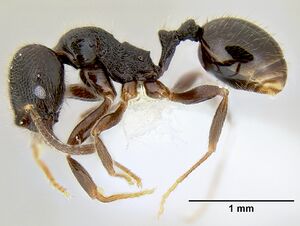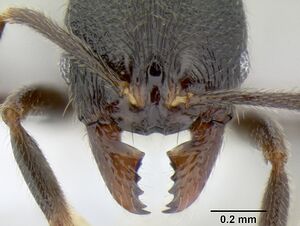Stenamma muralla
| Stenamma muralla | |
|---|---|

| |
| Scientific classification | |
| Kingdom: | Animalia |
| Phylum: | Arthropoda |
| Class: | Insecta |
| Order: | Hymenoptera |
| Family: | Formicidae |
| Subfamily: | Myrmicinae |
| Tribe: | Stenammini |
| Genus: | Stenamma |
| Species: | S. muralla |
| Binomial name | |
| Stenamma muralla Branstetter, 2013 | |
Stenamma muralla occurs in montane wet forest habitats (e.g. cloud forest, mixed hardwood forest, pine-mesophyll forest, ridgetop cloud forest, riparian cloud forest) from 1100–1900 m. It has been collected in extracts of sifted leaf litter, at cookie baits, beating vegetation, and in a flight intercept trap (single worker). Nests have been found by general searching in a variety of microhabitats, including wet clay banks along streams, dry clay banks along road cuts (in forest), in dead wood, in the base of a tree fern, and in mud at the base of a fallen tree. Nests are of moderate size and usually contain a few chambers. (Branstetter 2013)
Identification
Branstetter (2013) - Integument mostly black or dark brown to brown; small- to medium-sized species (see HL, ML, PrW below); lateral margin of hypostomal bridge with a projecting subquadrate lobe, visible behind mandible in profile view; waist segments appearing somewhat slender, with postpetiole particularly small; eye relatively large (EL 0.13–0.16, REL 19–22), with 6–9 ommatidia at greatest diameter; anterior clypeal margin with a median emargination; basal margin of mandible straight; propodeal spines tuberculate (PSL 0.08–0.11, PSI 1.1–1.4); frontal lobes well-developed, but not completely covering torular lobes in full-face view (FLD 0.16–0.19, FLI 24– 28); head densely sculptured with carinulae, rugoreticulae, and faint punctae; mesosoma mostly sculptured, but pronotal sculpture variably effaced, sometimes mostly smooth and shiny; gastral setae mostly suberect, long, and relatively sparse.
Stenamma muralla is similar to Stenamma leptospinum, Stenamma longinoi, and Stenamma manni because all have the lateral margin of the hypostomal bridge enlarged into a subquadrate lobe. However, S. muralla is easy to identify by its smaller size, more slender waist segments, and largely effaced pronotal sculpture. A few other species might look superficially like S. muralla, but these will not have the enlarged hypostomal lobe.
Keys including this Species
Distribution
Honduras to Nicaragua.
Latitudinal Distribution Pattern
Latitudinal Range: 15.09969° to 13.5673°.
| North Temperate |
North Subtropical |
Tropical | South Subtropical |
South Temperate |
- Source: AntMaps
Distribution based on Regional Taxon Lists
Neotropical Region: Honduras (type locality), Nicaragua.
Distribution based on AntMaps
Distribution based on AntWeb specimens
Check data from AntWeb
Countries Occupied
| Number of countries occupied by this species based on AntWiki Regional Taxon Lists. In general, fewer countries occupied indicates a narrower range, while more countries indicates a more widespread species. |

|
Estimated Abundance
| Relative abundance based on number of AntMaps records per species (this species within the purple bar). Fewer records (to the left) indicates a less abundant/encountered species while more records (to the right) indicates more abundant/encountered species. |

|
Biology
Castes
An interesting phenomenon in S. muralla is the regular occurrence of workers that are distinctly larger, and have the pronotum more densely sculptured with longitudinal rugulae/carinulae. Interestingly, the size difference seems to be discrete, rather than continuous. These specimens have been found in leaf litter samples as well as in nests, so they must be conspecific. They could be workers with queen-like traits (queens are larger than standard workers), but other than size and sculpture there are no further indications that they are intercastes. Another hypothesis is that they are a soldier-like worker caste. However, they do not show any allometric size differences. (Branstetter 2013)
Males have yet to be collected.
Worker
Images from AntWeb
     
| |
| Worker. Specimen code casent0622049. Photographer Michael Branstetter, uploaded by Default Group. | Owned by MGBPC. |
  
| |
| Holotype Stenamma muralla. Worker. Specimen code casent0621311. Photographer Michael Branstetter, uploaded by Default Group. | Owned by USNM. |
Queen
Images from AntWeb
   
| |
| Paratype Stenamma muralla. Queen (alate/dealate). Specimen code casent0622025. Photographer Michael Branstetter, uploaded by Default Group. | Owned by USNM. |
Nomenclature
The following information is derived from Barry Bolton's Online Catalogue of the Ants of the World.
- muralla. Stenamma muralla Branstetter, 2013: 191, figs. 125, 126 (w.q.) HONDURAS, NICARAGUA.
- Type-material: holotype worker, 14 paratype workers, 1 paratype queen.
- Type-locality: holotype Honduras: Olancho, Parque Nac. La Muralla, 15.09969°N, 86.74673°W±20m., 1530 m., 2.v.2010, LLAMA Wa-C-01-1-37; paratypes with same data but 15.09859°N, 86.74216°W±10m., 1531 m., 2.v.2010, LLAMA Wm-C-01-1-03.
- Type-depositories: USNM (holotype); CASC, CFSS, EAPZ, FMNH, ICNB, INBC, JTLC, LACM, MCZC, MGBC, MZSP, UCDC, UNAM, USNM (paratypes).
- Distribution: Honduras, Nicaragua.
Unless otherwise noted the text for the remainder of this section is reported from the publication that includes the original description.
Description
Worker
(10 measured) HL 0.72–0.83 (0.74), HW 0.63–0.75 (0.67), FLD 0.16–0.19 (0.17), PCW 0.03–0.06 (0.04), SL 0.57–0.67 (0.59), EL 0.13–0.16 (0.13), ACL 0.56–0.62 (0.56), ML 0.89–1.08 (0.90), PrW 0.43–0.50 (0.44), PSL 0.08–0.11 (0.09), SDL 0.07–0.09 (0.08), PL 0.31–0.42 (0.32), PH 0.19–0.24 (0.19), PW 0.13–0.19 (0.15), PPL 0.18–0.24 (0.18), PPH 0.14–0.20 (0.15), PPW 0.17–0.24 (0.18), MFL 0.68–0.79 (0.70), MTL 0.54–0.65 (0.56), CI 87–90 (90), SI 88–95 (88), REL 19–22 (19), FLI 24–28 (25), PSI 1.1–1.4 (1.2), MFI 90–98 (96), ACI2 63–66 (65), ACI2 92–99 (96).
Small- to medium-sized species; general body color black or dark brown to brown, with appendages brown to yellow-brown; setae golden brown; mandible with 6 teeth, but two teeth nearest the basal tooth smaller, often worn and indistinct or denticulate; basal margin of mandible straight, without basal notch or depression; mandible surface mostly smooth and shiny, with scattered piligerous punctae and basal striae; anterior clypeal margin with a median emargination; median lobe of clypeus with a few faint punctae, but lacking longitudinal carinulae, apex with a faint transverse carinula; remainder of clypeus mostly smooth and shiny; posterior extension of clypeus between antennal insertions of moderate width (PCW 0.03–0.06), sides subparallel; frontal lobes well-developed (FLD 0.16–0.19, FLI 24–28), but not completely obscuring torular lobes in full-face view; frontal carinae weak, fading into facial sculpture beyond frontal lobes, not surpassing level of anterior margin of eye; head oval-shaped (CI 87–90), posterior margin slightly depressed medially; eye relatively large (EL 0.13–0.16, REL 19–22), oval-shaped, with 6–9 ommatidia at greatest diameter; face densely sculptured with longitudinal carinulae along midline, turning into rugulae and rugoreticulae toward lateral margins, interstices punctate; scape of moderate length (SI 88–95), nearly reaching posterior margin of head when laid back; scape surface with a variable amount of fine punctae and striae; flagellum with distinct 4-segmented antennal club; pronotal sculpture mostly smooth and shiny, or with dense longitudinal rugulae and faint punctae, or with intermediate states with rugulae somewhat effaced (especially on pronotal side); mesonotal dorsum with fine carinulae and punctae; mesopleuron mostly punctate, with a few rugulae; propodeal side with rugulae and some punctae; propodeal dorsum and declivity with transverse carinulae; promesonotum in profile usually low-domed and roughly symmetrical, some specimens with promesonotum more robust, higher; metanotal grove well demarcated, of moderate depth and width; propodeal spines present as small tubercles (PSL 0.08–0.11, PSI 1.1–1.4); petiole and postpetiole appearing somewhat delicate with nodes relatively small (PL/HW 0.48–0.57, PH/PL 0.56–0.63, PPH/PH 0.74–0.84); petiolar node in profile pointing posteriad, with dorsum gently rounded; ventral surface of node concave; postpetiole in profile with a long shield-like anterior face and a short vertical posterior face, anterior half constricted; anterior faces of petiolar and postpetiolar nodes usually mostly smooth and shiny, remaining surface of waist segments mostly punctate; gaster mostly smooth and shiny, with scattered piligerous punctae and a few short striae around anterior constriction; most of body dorsum with moderately long standing pilosity; setae on scape suberect to appressed; gastral setae mostly suberect, long, and relatively sparse, a few shorter decumbent setae also present; setae on legs mostly subdecumbent to appressed, with suberect setae on coxae and femoral venters.
Queen
(5 measured) HL 0.76–0.79 (0.79), HW 0.68–0.72 (0.72), FLD 0.19–0.21 (0.20), PCW 0.04–0.06 (0.05), SL 0.62–0.63 (0.63), EL 0.21–0.22 (0.22), ACL 0.59–0.61 (0.59), ML 1.11–1.19 (1.18), PrW 0.63–0.67 (0.67), PSL 0.12–0.13 (0.13), SDL 0.10–0.12 (0.12), PL 0.42–0.45 (0.44), PH 0.23–0.25 (0.25), PW 0.17–0.19 (0.18), PPL 0.21–0.24 (0.22), PPH 0.20–0.23 (0.20), PPW 0.24–0.25 (0.25), MFL 0.74–0.79 (0.77), MTL 0.61–0.65 (0.63), CI 89–91 (91), SI 89–91 (89), REL 30–31 (30), FLI 28–29 (28), PSI 1.1–1.3 (1.1), MFI 90–93 (93), ACI1 63–65 (65), ACI2 94–98 (94).
Same as worker except for standard queen modifications and as follows: pronotum transversely carinulate/rugulose; mesoscutum and scutellum densely carinulate; mesopleuron mostly smooth and shiny; propodeum transversely carinulate, with carinulae wrapping around entire surface; petiole and postpetiole slightly more robust, with dorsum of petiolar node reaching a slightly more defined apex; gastral pilosity more dense.
Type Material
Holotype worker. HONDURAS: Olancho, Parque Nacional La Muralla, 15.09969°N, 86.74673°W ±20m, 1530m, 2 May 2010, cloud forest, ex sifted leaf litter (LLAMA, collection Wa-C-01-1-37) USNM, specimen CASENT0621311. Paratypes: same data as holotype but 15.09859°N, 86.74216°W ±10m, 1510m, 2 May 2010 (LLAMA, Wm-C-01-1-03) 1w, CASC, CASENT0622027, 1w, EAPZ, CASENT0623371, 1w, ECOSCE, CASENT0623372, 1w, FMNH, CASENT0623373, 1w, ICN, CASENT0623374, 1w, INBC, CASENT0623375, 1w, JTLC, CASENT0623376, 1w, LACM, CASENT0623377, 1w, MGBPC, CASENT0623378, 1w, MCZ, CASENT0623379, 1w, MZSP, CASENT0623380, 1w, UCDC, CASENT0623381, 1w, UNAM, CASENT0623382, 1dq, 1w, USNM, CASENT0622025, CASENT0622026 1w, UVGC, CASENT0623383.
References
- Branstetter, M. G. 2012. Origin and diversification of the cryptic ant genus Stenamma Westwood (Hymenoptera: Formicidae), inferred from multilocus molecular data, biogeography and natural history. Systematic Entomology 37:478-496. doi:10.1111/j.1365-3113.2012.00624.x
- Branstetter, M.G. 2013. Revision of the Middle American clade of the ant genus Stenamma Westwood (Hymenoptera, Formicidae, Myrmicinae). ZooKeys 295, 1–277. doi:10.3897/zookeys.295.4905
References based on Global Ant Biodiversity Informatics
- Branstetter M.G. 2013. Revision of the Middle American clade of the ant genus Stenamma Westwood (Hymenoptera, Formicidae, Myrmicinae). ZooKeys 295: 1277
- Longino J. T. L., and M. G. Branstetter. 2018. The truncated bell: an enigmatic but pervasive elevational diversity pattern in Middle American ants. Ecography 41: 1-12.


